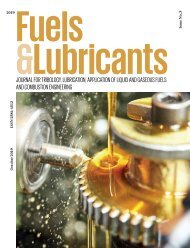Fuels & Lubricants Magazine
Issue No. 3, October 2018
Issue No. 3, October 2018
Create successful ePaper yourself
Turn your PDF publications into a flip-book with our unique Google optimized e-Paper software.
GREEN CORNER<br />
gases is needed. The relative relation and extent of the<br />
side reactions are calculated from the distribution of<br />
secondary products: carbon monoxide, carbon dioxide<br />
and methane.<br />
CO 2<br />
+ H 2<br />
—> CH 4<br />
+ H 2<br />
O (2)<br />
Hydrogen consumption during the decarboxylation<br />
or hydrodeoxygenation reaction has a major influence<br />
on product yield distribution, inhibition of catalysts, gas<br />
composition and heat balance.<br />
If all triglycerides are reacted by decarboxylation,<br />
seven moles of hydrogen will be consumed in contrast<br />
to sixteen moles of hydrogen to be consumed if triglycerides<br />
are converted by HDO mechanism, ie 63% lower<br />
hydrogen consumption. However, if all the carbon dioxide<br />
obtained is converted to carbon monoxide and then<br />
into methane, it will consume nineteen tons of hydrogen<br />
by decarboxylation, ie the consumption of hydrogen is<br />
19% higher [11].<br />
Therefore, the ratio of decarboxylation and hydrodeoxydation<br />
reaction mechanisms should be 65/35. The<br />
favourable relationship between the reaction mechanisms<br />
can be monitored by the analysis of the relative<br />
relation between n-C17 and n-C18 by the simulated<br />
distillation method. This relationship depends on the<br />
type of catalyst, the process conditions and the type of<br />
renewable feedstock.<br />
CONCLUSION<br />
The key parameters that show the quality of used cooking<br />
oil or waste animal fat for the hydrotreating process<br />
are the total acidity, water content, metal content and<br />
free fatty acids content.<br />
The used cooking oil is more suitable feedstock than<br />
animal fat due to lower acid number, kinematic viscosity<br />
and significantly lower metal content. Such properties<br />
make used cooking oil more suitable for direct coprocessing<br />
in refinery units by known conversion processes.<br />
The reactions of UCO hydrotreating are exothermic<br />
so during co-processing increasing of temperature in the<br />
catalyst layer should be noticed which could have the<br />
impact on duration of the catalyst.<br />
The key barrier for the independent processing of<br />
UCO and animal fats in refinery units is the limit availability<br />
of the feedstock. Also, for continuous co-processing,<br />
it is recommended to upgrade the hydrodesulfurization<br />
unit with isomerisation unit to have a possibility<br />
to convert the n-paraffins partly into iso-paraffins to<br />
improve low-temperature properties of the obtained<br />
diesel fuel.<br />
Hydrotreating of used cooking oil and animal fats for<br />
the production of hydrotreated vegetable oil used as<br />
a fuel in transport is a promising technology that will<br />
inevitably develop in the following years in European<br />
Union countries or in oil companies in order to replace<br />
part fossil fuels with renewable fuels in economically and<br />
environmentally effective way.<br />
LITERATURE<br />
[1] URL: http://eur-lex.europa.eu/legal-content/HR/<br />
TXT/PDF/?uri=CELEX:32015L1513&from=HR (access:<br />
June, 22th 2018)<br />
[2] M. Crocker, Thermochemical conversion of biomass<br />
to liquid fuels and chemicals, Royal Society of Chemistry,<br />
UK, 2010, p. 1-25.<br />
[3] D. Sperling, D. Gordon, Two Billion Cars: Driving Toward<br />
Sustainability, Oxford University Press, 2009, p. 6-7.<br />
[4] M. Guo, W. Song, J. Buhain, Bioenergy and biofuels:<br />
History, status, and perspective, Renew. Sust. Energ.<br />
Rev. 42 (2015) 712-725.<br />
[5] L. Zhang, G. Hu, Supply chain design and operational<br />
planning models for biomass to drop-in fuel production,<br />
Biomass Bioenerg 58 (2013) 238-250.<br />
[6] M. F. Ali, M. E. Ali Bassam, J. G. Speight, Handbook<br />
of Industrial Chemistry, Organic Chemicals, McGraw-<br />
Hill, New York, 2014, p. 528-537.<br />
[7] Izvješće o posebnim kategorijama otpada za 2016.<br />
godinu, Hrvatska agencija za okoliš i prirodu, travanj<br />
2018. p. 7 - 9<br />
[8] S. J. Miller, Production of Biofuels and Biolubricants<br />
From a Common Feedstock, US Patent Publication No.<br />
0084026, 2009, p. 1-2.<br />
[9] M. J. McCall; A. Anumakonda, A. Bhattacharyya, J.<br />
Kocal, Feed-Flexible Processing of Oil-Rich Crops to<br />
Jet Fuel, AIChE Meeting, Chicago, 2008.<br />
[10] B. Donnis; R. G. Egeberg, P. Blom, K. G. Knudsen,<br />
Hydroprocessing of Bio-Oils and Oxygenates to Hydrocarbons,<br />
Understanding the Reaction Routes, Topics in<br />
Catalysis 52 (3) (2009) 229-240.<br />
[11] R. G. Egeberg, N. H. Michaelsen, L. Skyum, Novel<br />
hydrotreating technology for production of green diesel,<br />
Haldor Topsoe, 2010, 6-9.<br />
28 <strong>Fuels</strong>&<strong>Lubricants</strong> No. 3 OCTOBER 2018







